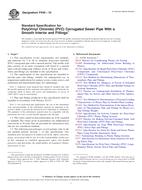Wir benötigen Ihre Einwilligung zur Verwendung der einzelnen Daten, damit Sie unter anderem Informationen zu Ihren Interessen einsehen können. Klicken Sie auf "OK", um Ihre Zustimmung zu erteilen.
ASTM F1057-10
Standard Practice for Estimating the Quality of Extruded Poly (Vinyl Chloride) (PVC) Pipe by the Heat Reversion Technique
Automatische name übersetzung:
Standard Praxis zur Abschätzung der Qualität von Extruded Poly (Vinylchlorid) (PVC) Rohr durch den Wärme Reversion-TechnikNORM herausgegeben am 1.5.2010
Informationen über die Norm:
Bezeichnung normen: ASTM F1057-10
Anmerkung: UNGÜLTIG
Ausgabedatum normen: 1.5.2010
SKU: NS-48963
Zahl der Seiten: 7
Gewicht ca.: 21 g (0.05 Pfund)
Land: Amerikanische technische Norm
Kategorie: Technische Normen ASTM
Kategorie - ähnliche Normen:
Die Annotation des Normtextes ASTM F1057-10 :
Keywords:
heat reversion, PVC pipe, Extrusions, Heating tests--plastics, Heat reversion technique, Poly(vinyl chloride)(PVC) pipe--specifications, ICS Number Code 23.040.20 (Plastic pipes)
Ergänzende Informationen
| Significance and Use |
|
This practice is applicable to distinguish between properly and improperly extruded PVC plastic pipe. It can be used to: Reveal incomplete exsiccation of compound before or during extrusion (Note 1), Determine the presence of stress in the pipe wall produced by the extrusion process (Note 2), Determine whether infused areas are present, and Reveal contamination. Note 1—Residual moisture in the compound vaporizes at extrusion temperatures and is normally evacuated as it forms vapor. Pockets of moisture trapped in the pipe wall result from incomplete exsiccation of the compound, and may reduce the physical properties of the pipe. Note 2—Minor residual stress in the pipe will not impair field performance and handleability. High-residual stress has no proven effect on performance, but may impair handleability during installation. |
| 1. Scope |
|
1.1 This practice covers a procedure for estimating the quality of extruded poly (vinyl chloride) (PVC) plastic pipes by observing the reaction of pipe specimens after exposure to hot air in the oven at 180 ± 5°C for 30 min duration. 1.2 This standard does not purport to address all of the safety problems, if any, associated with its use. It is the responsibility of the user of this standard to establish appropriate safety and health practices and determine the applicability of regulatory limitations prior to use. |
Ähnliche Normen:
Historisch
1.8.2013
Historisch
1.8.2011
Historisch
1.5.2010
Historisch
1.8.2013
Historisch
1.8.2011
Historisch
1.2.2010
Empfehlungen:
Aktualisierung der technischen Normen
Wollen Sie sich sicher sein, dass Sie nur die gültigen technischen Normen verwenden?
Wir bieten Ihnen eine Lösung, die Ihnen eine Monatsübersicht über die Aktualität der von Ihnen angewandten Normen sicher stellt.
Brauchen Sie mehr Informationen? Sehen Sie sich diese Seite an.



 ASTM F876-13a
ASTM F876-13a ASTM F877-11a
ASTM F877-11a ASTM F891-10
ASTM F891-10 ASTM F894-13
ASTM F894-13 ASTM F948-94(2011)..
ASTM F948-94(2011).. ASTM F949-10
ASTM F949-10
 Cookies
Cookies
